The DentaLink S6000, also known as the Fussen intraoral scanner (IOS), is a low-cost, entry-level scanner made by Fussen Technology Co., Ltd., a Chinese-based company. There has been a boom in cheap intraoral scanners released onto the market in recent years - many of these coming from China. Over five different intraoral scanners are made in the country, the popular ones being: Runyes, DentaLink, Panda, Shining 3D, and Launca.
The team at iDD was fortunate to receive the first DentaLink S6000 IOS in New Zealand and one of the first in the entire Asia-Pacific region. We have been testing this scanner for months. The following review goes over our experiences and how this scanner compares to all others on the market.
Background
Fussen is a large company based in Shenzhen, China. Founded in 2010, they employ over 400 staff and service over 80,000 clinics, predominantly in China. The company aims to develop simplified technology to help dental clinics capture information with an innovative digital product line of systems and solutions. This is in effort to improve dentistry and transform it for improved treatment efficiency, precise diagnoses, and superior patient care.
Fussen has a large number of offerings in China, including practice management systems, cloud-based data management, imaging analysis software, intraoral, extraoral imaging equipment, and CAD/CAM systems. They have a range of different products, mainly focusing on dental radiography and CBCTs.
In 2020 they launched their first intraoral scanner, the DentaLink S6000. The DentaLink S6000 has been in development for the past five years and was released in October 2020. The scanner is one of the most affordable scanners on the market. The question is, are these low-cost Chinese products any good? The competitive landscape for intraoral scanners has been heating up for years, and there have never been so many options now.
The key barriers to the adoption of intraoral scanning technology continue to be the investment cost and learning curve. The DentaLink IOS may find its place in the market by tackling this barrier head-on. It is competitively priced, with free software upgrades and no additional ongoing costs.
So how does this scanner compare to other scanners that are dominating the low-cost scanner space? Find out more below.
Disclaimer - no conflict of interest. This is an objective review of the DentaLink S6000 IOS. The team at iDD remains unwaveringly committed to providing you with impartial and trustworthy information. Fussen had no part in writing this review or restricting any conclusions iDD makes in our thorough analysis and clinical use of these products.
Enjoy the review.


Review Overview
Evaluation Ratings
Scanning Speed
Scanning Flow
Scanner Size
Ease of Use
Scanner Software
Investment Cost
Additional Features
USB/CART
USB Only
Wireless Scanner
Caries Detection
Software Apps
No apps
CAD/CAM Software
Relies on 3rd Party Software
Subscription
Requirements
None. No ongoing fees.
Autoclavable Tips
25 times per tip
Scanning Speed
The DentaLink S6000 is average in terms of scan speed. The scanner itself feels like it is capable but is held back by the software that lags behind your movements. In other words, the fabrication of the digital impression on the screen is visually delayed compared to where your hand has moved (watch the video below). This is even the case on our high-end computer, which runs all intraoral scanners with ease. It is the software itself, not necessarily the scanner, that makes the entire scanning experience feel a little sluggish and slow.
Even when considering the low cost of the DentaLink S6000, other low-cost scanners can produce a smoother scanning experience. Although we can achieve full-arch scans using the DentaLink S6000 within 60 seconds, this by no means feels very easy, and we can see why new users may struggle with this scanner.
Achieving a full arch scan is one thing, but making it an enjoyable and straightforward process is another. Is this an easy scanner to use? Not entirely. The reason being is that the scanner picks up artefacts easily (such as the cheeks) and demands a perfect scanning strategy and tissue retraction.
Anyone familiar with IOS scan strategies will be able to use this scanner. The software is very simplistic. It is used in a way that is similar to all other IOS on the market. The artificial intelligence (AI) built into the software is passable but not the best.
It is quick to find its place again when the scan is paused and restarted, bite scans are stitched together very quickly, but removing artefacts is a weak point. The software does not do this automatically while scanning and only removes soft tissue artefacts it identifies once the scan process is stopped, or the area is rescanned. Even when this is the case, it does seem to leave behind many artefacts and unwanted scan data, even when they obviously don't belong to the oral cavity (e.g., blue gloves).
When taking a scan using the DentaLink S6000, the scanning image fabricated by the software has a cartoon aesthetic. There are no loading screens between each scan which is, in our opinion, the preferred workflow, and makes the workflow a lot faster. Instead, all the processing occurs after all scans are completed.
The final processed images look life-like but occasionally areas of the scan are rendered incorrectly, showing a bizarre black shadow on incisal edges. Overall, it's an above average scanning experience.

The DentaLink Scanner unboxed. Four scanner tips also come with the scanner.
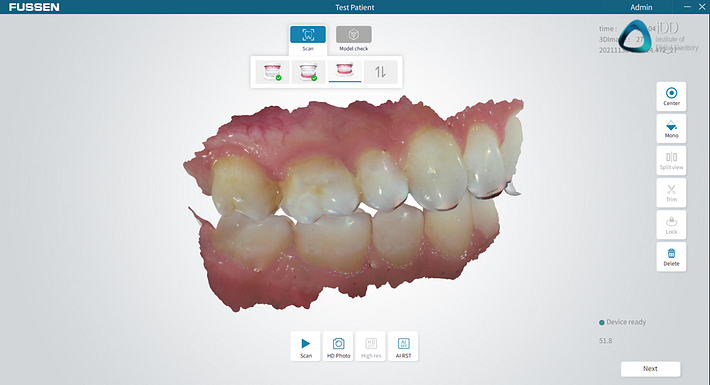
Images produced by the DentaLink S6000 look life-like but can have bizarre colour rendering at incisal edges.
Scanner Size & Ergonomics
Ergonomically the DentaLink scanner is, again, average. To say it has taken inspiration from Carestream Dental intraoral scanners is putting it lightly, but it fails to achieve the same level of ergonomic design as its inspiration.
The scanner weighs 350 grams. Meaning it is in the middle of the pack in weight compared to the entire market, yet heavier than many other 'low-cost' scanners it is competing with, such as the Heron IOS (150 grams), the Medit i700 (245 g), and Medit i500 (280 g), and a range of other Chinese scanners. The CS 3700 that Fussen takes inspiration from weighs 316g. Furthermore, the DentaLink S6000 is lighter than the TRIOS 4 (340g), CEREC Primescan (457 - 525g) or iTero Element 5D (~500g).
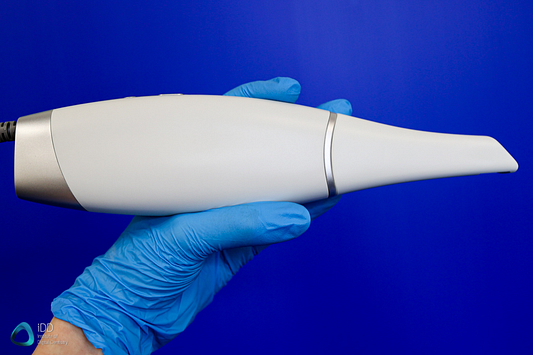
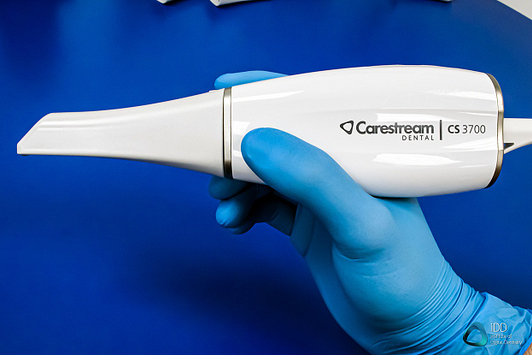
Spot the difference. Fussen DentaLink IOS (left) and Carestream Dental CS3700 (right)
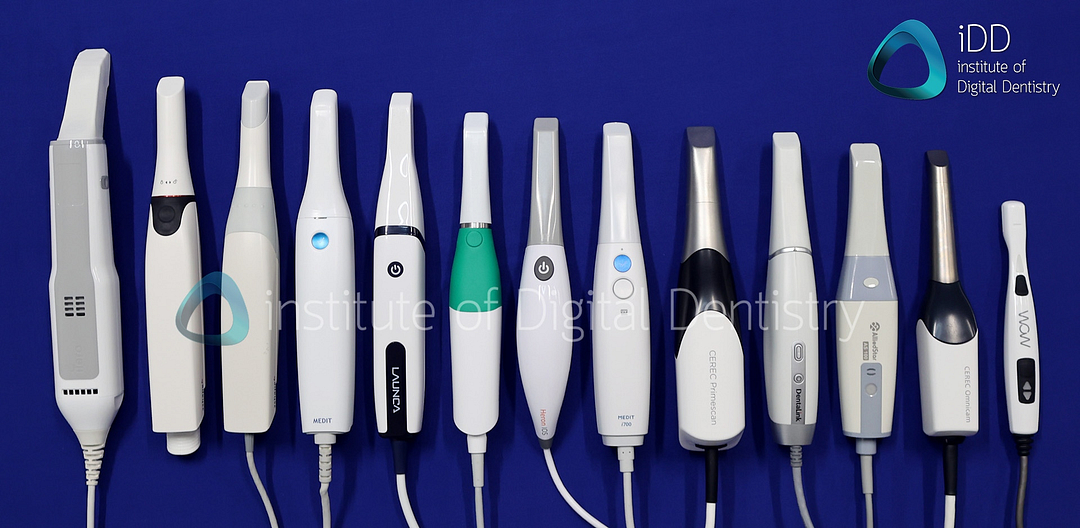
All intraoral scanners at the Institute of Digital Dentistry arranged by height.
The DentaLink scanner is fourth from the right.
The scanner is relatively narrow and deep, making it fit in hand a little awkwardly. The exact dimensions of the scanner are 240 x 39.8 x 57 mm. The scanner tips are 28mm x 60mm x 19mm. The DentaLink S6000 comes with four tips.
The DentaLink IOS has a simplistic but modern design. It has only two buttons near the back of the scanner, on the top. One button is used to turn the scanner itself on and off. The other button is used to start and stop the scanning process.
Once turned on, a blue light confirms this, and the fan inside the scanner can be heard humming. This fan blows air onto the mirror and is audible. There are no other buttons on the scanner, and to remove scanner heads, you pull them off.
The scanner has a good build quality and feels like a solid product. The low-cost scanner market has been flooded with products, and some feel cheap. This is not the case here.


DentaLink S600 is modern looking and well built.

DentaLink S6000 comes with four scanning heads. Each can be autoclaved 25 times.
The main issue with the ergonomics of this scanner is that the scanning button is found right at the back near the logo. This means it is uncomfortable to press the scanning button on and off when holding the scanner with one hand in a pen grip. Alternatively, you can hold the scanner higher up to access the button, but this makes it more awkward to hold. Why this design choice was selected is questionable as most manufacturers place this button near the finger grip for easy access when holding the scanner.
The scanner base that comes with the DentaLink S6000 scanner is simple and fit for purpose. It is small and holds the scanner securely in place. It is a little bit lightweight for our liking but seems stable enough that it should not cause an issue. Unlike other scanners, it has no other purpose with no cables going into the base.


The scanner base is small enough to not be in the way and holds the scanner neatly.
Only one cable comes from the scanner which has a unique splitter that separates the USB and power cables. The power cable is then connected to the end of the scanner cable.
A common problem with USB scanners is cable management. When using the scanner, it is connected to a computer via USB 3.0, and both the laptop and scanner must be plugged into a power source at all times during use. The DentaLink makes this tidier as the power cable is out of the way near the computer. We quite like this unique design as it means that cable management is a lot neater.


The DentaLink S6000 has one cable coming from it that connects to the computer via USB 3.0
Inbuilt Fan
The DentaLink IOS has an inbuilt fan in the scanner to prevent fogging. Like almost every scanner on the market, this makes it easier to scan in the mouth without condensation issues on the scanner tip. We noticed that the DentaLink does require a lot of time to heat up fully, over 2-3 minutes. This is longer than many other scanners.
The fan itself also seems to not be powerful enough in all cases, as if the patient breathes out heavily, the mirror still occasionally fogs. Adding to this, unfortunately, the software does not indicate when the tip of the scanner is hot enough to scan without fogging the scanner mirror. If the scanner is used without enough time for heating up, it will scan the condensation resulting in unusable digital impressions.
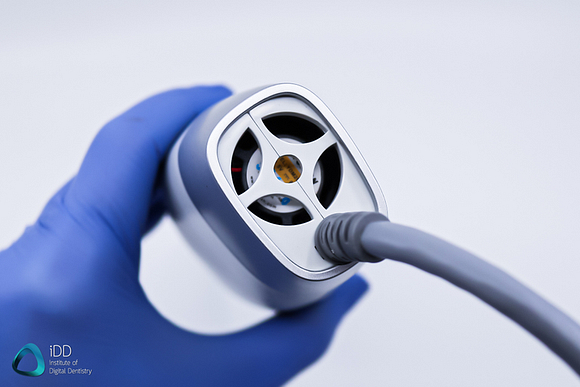
The fan at the back of the DentaLink S6000 that blows air on the scanning head.
Full Arch Scanning
The DentaLink IOS handles full arch scans reasonably well. As mentioned above, we could carry out full arch scans within one minute. Taking full arch scans quickly is no longer an impressive feat for a scanner, as this has become the market norm. Now it is a software game and how easy does the software make this process.
DentaLink IOS has the usual recipe for full arch scanning: decent scan speed, picking up where you stop the scanner quickly, and an inbuilt fan that prevents fogging and enables long periods of uninterrupted scanning. It follows a similar scan protocol to all other scanners.
As mentioned above, the main issue is that the DentaLink scanner feels fast but is held back by the software. The software is laggy and captures artefacts easily. The software also seems to colour render the digital images incorrectly in certain places, typically incisal edges.

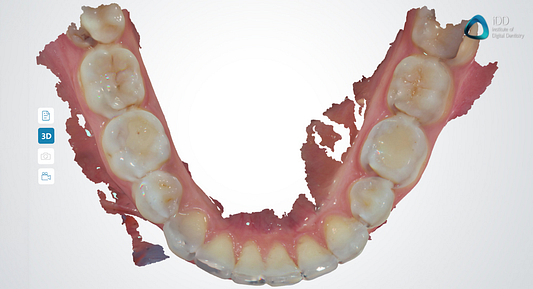
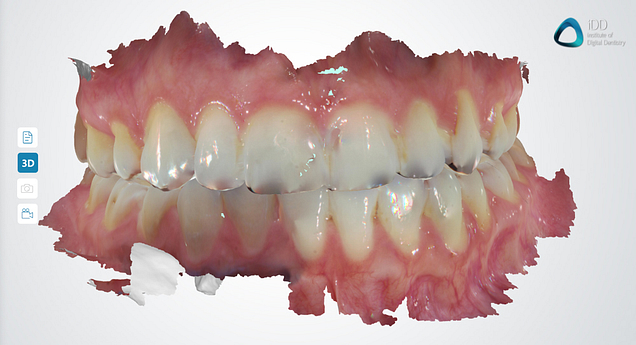
Full arch scans using the DentaLink S6000 IOS.
Life-like aesthetic with some incorrect colour rendering.
The company recommends the scanner is only used for orthodontic appliances, crowns, veneers, bridges (up to 5 units), and implants (up to 3 units). It, therefore, is not meant to be used for edentulous arches and struggles in this aspect. For small edentulous sites and scanning implants, the DentaLink scanner works fine.
In terms of its accuracy in full-arch scanning, no research exists about the DentaLink IOS. We have used it to fabricate same-day crown and bridge restorations within our clinic with no problem. The colour rendering is an issue, however, that the company needs to solve urgently.
We would not recommend this scanner for more complicated indications. The company itself states that the single unit accuracy is 10μm(±1.1μm), quadrant scan accuracy is 22μm(±3.5μm), and full arch scan accuracy is 32μm(±11μm).
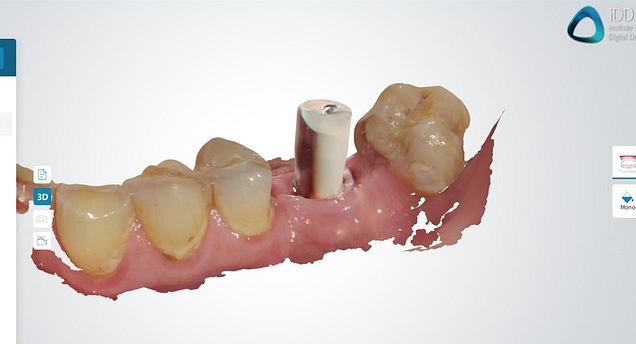
Digital impression of a scanbody using the Fussen IOS
Calibration-free
The DentaLink S6000 does not come with a calibration tool for the scanner. This is becoming somewhat of a market trend with many low-cost scanners claiming no calibration is required as long as the scanner is not damaged/dropped.
Being calibration-free is an interesting concept also seen in Carestream Dental, Heron, and iTero line of intraoral scanners. Most scanners on the market require frequent calibration with an included calibration tool.
The manufacturer claims that calibration is not required unless there is an external shock to the scanner (such as dropping it). In these cases, the company will need to replace the scanner. The scanner also does not come with a color calibration tool.
The benefit of not needing a calibration tool is that the user does not have to worry about calibrating the scanner before cases and will save time. The downside is that the user will not know if scanner accuracy is optimal and whether the scanner is performing correctly.
Fussen IOS Software
The software the runs DentaLink is intuitive and easy to use. The downside is that the software is a little too simple and looks dated. The software itself does not offer much more than scanning and exporting of cases in several different formats.
Essential scanner software functions such as analyzing occlusion or reduction space, editing scans, removing any scan data, etc., are all present in the software, but that's it. Some other essential functions like checking for undercuts are present, yet others like marginating preps for your lab are not.
The DentaLink software has several features in China that are not yet available outside the country of origin. For example, cloud storage. At the moment, all scans are stored locally. Do not expect to see smile design or other 'patient motivating' applications here. This is just very basic scanner software.

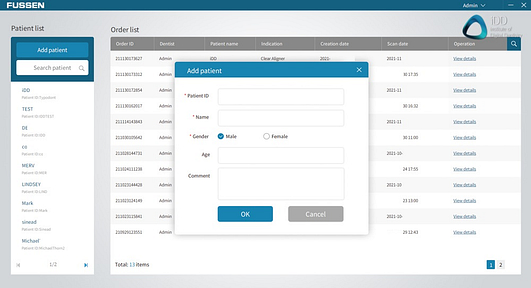
Simple and intuitive software. Looks dated however.
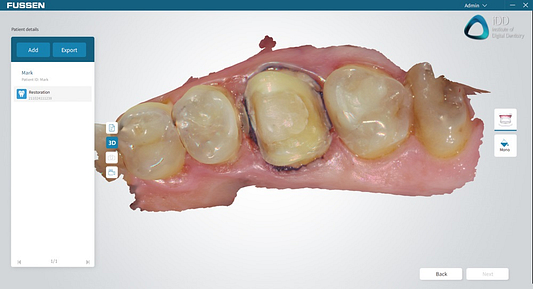
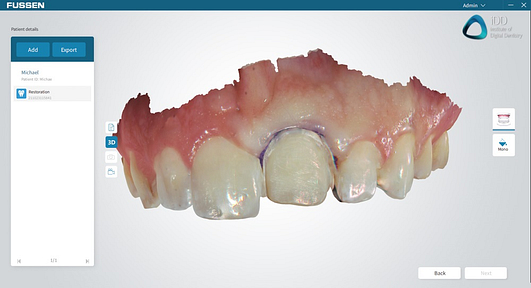
Scans carried out using the Fussen IOS.
Ease of Use
As with almost every scanner on the market, the Fussen software makes the workflow as easy as possible. The software is indeed easy to use, and the workflow is straightforward.
Ease of use comes from the software that supports the hardware. The workflow is intuitive and follows a simple step-by-step progression that is identical across every system on the market nowadays.
The typical workflow is as follows:
- Filling out the patient details
- Scanning the preparation
- Scanning the opposing teeth
- Scanning the bite
The UI is intuitive but, unfortunately, lacks a lot of options. This can be confusing to new users. For example, the lab form part of the software is very limited (e.g. cannot choose restoration shade or material), has some errors, and generally needs improvement.
Using the software is easy enough, and thankfully processing of scans is done quickly. The workflow itself is efficient. It does lack some quality of life benefits we see in other scanners, like being able to start scanning immediately and then return to the lab form later if you are in a rush.
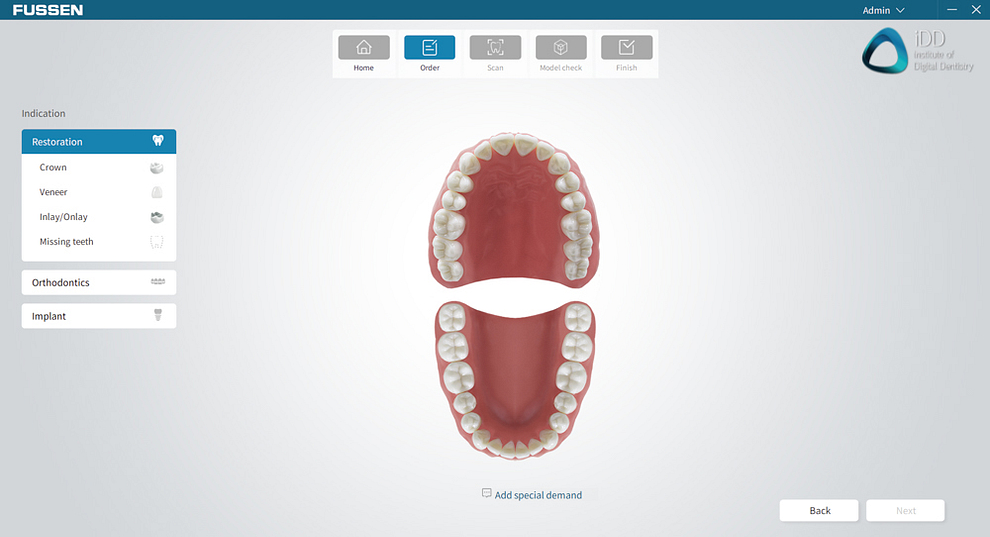
The workflow starts here with inputting patient details and case information.
The menus are very simple and lack many options.
The main downside of the software is how basic it is. There are no applications or additions such as model builder, smile design, or orthodontic simulators (in China, the company does have an orthodontic simulator enabled). The lack of software applications may be fine in the Chinese market, but outside of China most other scanners are investing in their software significantly. Even if this scanner is the cheapest on the market, it leaves a lot to be desired.
Furthermore, the software does not design any prosthetics nor has any design aspects. The DentaLink IOS is just a scanner and has no CAD design software. For those looking to carry out the entire workflow in-house, this scanner will need to be combined with third-party CAD software and milling machines.
Overall the software works fine, but the user interface needs a significant update.
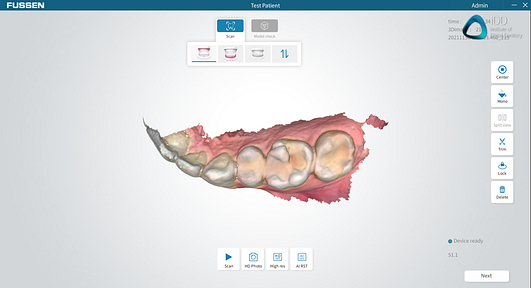
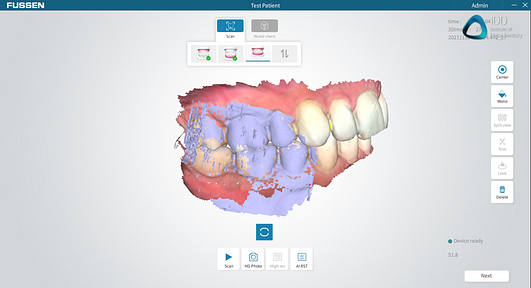
The tools available are very rudimentary.
Open or Closed Architecture
The DentaLink IOS is entirely open. The software enables easy exporting of scans in multiple different formats. This includes the popular STL file type but also OBJ and PLY.
You are will primarily use STL, as this is the most widely accepted scanning format across labs and software. One key distinction to make is that the STL file is NOT a color file. Although the scanner scans in color, you will be designing on a monochrome model when exporting in STL and opening in design software. OBJ and PLY files include color details, and it is great to see both being offered as export options.
The software makes exporting these scans very straightforward.
Invisalign users: for those of you who provide Invisalign treatment for their patients, Align will NOT accept DentaLink IOS scans for Invisalign treatment. You will need to consider other aligner options.
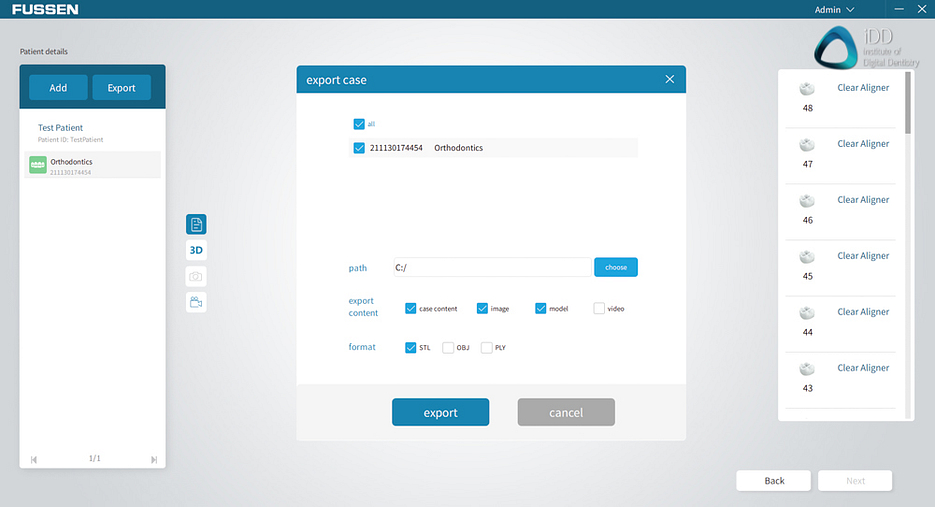
Exporting is simple and easy to do after scanning. STL, OBJ and PLY options exist.
Cost
The DentaLink S6000 scanner is one of the most affordable scanners on the market. The cost of the scanner is $13,000 USD. This makes it an entry-level scanner and one of the cheapest on the market.
An ongoing cost you need to consider is the scanning heads. DentaLink IOS has removable and autoclavable scanning heads, which provides ideal cross-infection control. This feature has become the norm across the entire IOS market.
The autoclavable scanning heads have a limit of 25 cycles, after which they will need to be replaced. This is the recommendation by the company, but they also say they have tested them up to 120 autoclave cycles with minimal accuracy loss. The cost of each scanning head for the DentaLink IOS is $50 USD ($2 USD per scan).
Yearly Fees / Subscription
The DentaLink IOS has no yearly fees or subscription costs.
The lack of subscription or yearly fees is becoming increasingly common in the IOS market, and it is great to see this is the case here too. Low cost and subscription-free is the way these Chinese scanners are going to penetrate the market.
DentaLink IOS does not currently have any cloud storage outside of China, so there is no fees for that either. All software updates are included for free with the scanner. There are absolutely no ongoing fees except for scanner heads.
Review Summary

To summarize, this is our in-depth review of the Fussen / DentaLink intraoral scanner. We have focused on the clinical aspects rather than technical specifications.
The DentaLink S6000 IOS is a scanner the offers an attractive price tag at $13,000 USD with no yearly fees and cheap scanning heads. Yet this comes at the cost of operational usability. It is slower than the competition but can produce an acceptable final product when we tested it in-house.
The main strength of the scanner lies in its price tag. Take that away from it, and it's questionable what the marketing edge here is. The problems with this scanner arise when you examine the software. The software looks dated, feels sluggish during scanning, and offers little apart from basic scanning functions. Some standard features like margination are not present in the software.
Fussen is focusing on a scanner-only approach and thus provides nothing else except scanning and exporting. This may not be enough in light its competitors, which often have a vast lineup of applications like a model builder and smile design applications. There are no applications found within the Fussen software outside of China.
The other major issue with the scanner software is how it renders colors. There are sometimes bizarre shadows rendered on the digital impressions that need to be sorted out by the company asap. It makes the otherwise life-like digital impressions unsightly.
As a stand-alone scanner option, we can see the merits of the Fussen IOS in China, where users can benefit from the companies large cloud network and other software additions. Outside of China it isn't clear what the competitive edge of this scanner is apart from being very cheap and producing acceptable scans.
As the price of scanners continues to fall, users must be careful to ensure the products they are buying have ample support and usability in their region.
We understand that this is Fussen's first intraoral scanner, and we hope that the company can build on the strengths of this product and improve next iterations significantly. The cost of scanners is dropping each year and this is beneficial for all clinicians worldwide as with the drop in price, adoption rates of digital technology will continue to increase.
If there is anything we did not cover, or if you have a question, please leave a comment below.


An useful and complete review!
Thank you 🙂
This Fussen / DentaLink intraoral scanner review is quite informative, honest and transparent. Excellent job.
Thanks for the kind words Ismael. Glad you found it helpful.
Dear Dr.
Is there a dealer in Europe our Belgium voor de Fussen. IOS
Kind regards,
Joris keirens
Hey Joris,
We personally do not distribute any scanner to remain objective so unfortunately, I am not aware of specific dealers in Europe.
I would recommend contacting Fussen directly on their website or socials, they will be able to point you in the right direction.
Kind regards
Buenas noches,
¿ podría darme su opinión del escáner FUSSEN S6500??
GRACIAS y Un Saludo!